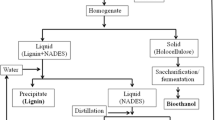Abstract
Ethanol produced from lignocellulosic biomass is a renewable alternative to diminishing petroleum-based liquid fuels. In this study, the feasibility of ethanol production from waste paper using the separate hydrolysis and fermentation (SHF) was investigated. Two types of waste paper materials, newspaper and office paper, were evaluated for their potential to be used as a renewable feedstock for the production of fermentable sugars via enzymatic hydrolysis of their cellulose fractions. Hydrolysis step was conducted with a mixture of cellulolytic enzymes produced locally by Trichoderma reesei Rut-C30 (cellulase-overproducing mutant) and Aspergillus niger F38 cultures. Surfactant pretreatment effect on waste paper enzymatic digestibility was studied and Triton X-100 at 0.5 % (w w−1) has improved the digestibility of newspaper about 45 %. The effects of three factors (dry matter quantity, phosphoric acid pretreatment and hydrolysis time) on the extent of saccharification were also assessed and quantified by using a methodical approach based on response surface methodology. Under optimal hydrolysis conditions, maximum degrees of saccharification of newspaper and office paper were 67 and 92 %, respectively. Sugars released from waste paper were subsequently converted into ethanol (0.38 g ethanol g−1 sugar) with Saccharomyces cerevisiae CTM-30101.





Similar content being viewed by others

References
Zhang, Y. H. P., Berson, E., Sarkanen, S., & Dale, B. E. (2009). Applied Biochemistry and Biotechnology, 153, 80–83.
Talebniaa, F., & Taherzadeh, M. J. (2012). Carbohydrate Polymers, 87, 2149–2153.
Rosgaard, L., Pedersen, S., & Meyer, A. S. (2007). Applied Biochemistry and Biotechnology, 143, 284–296.
Foyle, T., Jennings, L., & Mulcahy, P. (2007). Bioresource Technology, 97, 3026–3036.
Chen, M., Zhao, J., & Xia, L. (2008). Carbohydrate Polymers, 71, 411–415.
Bhat, M. K., & Bhat, S. (1997). Biotechnology Advances, 15, 583–620.
Saranraj, P., Stella, D., & Reetha, D. (2012). International Journal of Biochemistry and Biotech Science, 1, 1–12.
Nakari-Setala, T., & Penttila, M. (1995). Applied and Environmental Microbiology, 61, 3650–3655.
Wu, C. C., & Cheng, C. (2005). Journal of the Chinese Chemical Society, 52, 85–95.
Li, C., Matsunaga, T., Seki, K., Yoshimoto, M., Furumoto, K., Fukunaga, K., & Nakao, K. (2006). Chemical Engineering and Technology, 29, 1090–1096.
Dubey, A. K., Gupta, P. K., Garg, N., & Naithani, S. (2012). Carbohydrate Polymers, 88, 825–829.
Peng, L., & Chen, Y. (2011). Biomass and Bioenergy, 35, 1600–1606.
Zhang, Q., & Cai, W. (2008). Biomass and Bioenergy, 32, 1130–1135.
Guerfali, M., Chaabouni, M., Gargouri, A., & Belghith, H. (2010). Applied Microbiology and Biotechnology, 85, 1361–1372.
Aifa, M. S., Sayadi, S., & Gargouri, A. (1999). Biotechnology Letters, 21, 849–853.
Mandels, M., & Weber, J. (1969). Advances in Chemistry Series, 95, 394–414.
Ghose, T. K. (1987). Pure and Applied Chemistry, 59, 257–68.
Bailey, M. J., Biely, P., & Poutanen, K. (1992). Journal of Biotechnology, 23, 257–270.
Miller, G. L. (1959). Analytical Chemistry, 31, 426–428.
Yanai, T., & Sato, M. (1999). American Journal of Enology and Viticulture, 50, 231–235.
Browning, B. L. (1967). Methods of wood chemistry, vol 1: phenolic substances (pp. 223–251). New York: Wiley-Interscience Publishers.
Pathak, P., Bhardwaj, N. K., & Singh, A. K. (2011). BioResources, 6, 447–463.
Park, I., Kim, I., Kang, K., Sohn, H., Rhee, I., Jin, I., & Jang, H. (2010). Process Biochemistry, 45, 487–492.
Yamashita, Y., Sasaki, C., & Nakamura, Y. (2010). Carbohydrate Polymers, 79, 250–254.
Kim, H. J., Kim, S. B., & Kim, C. J. (2007). Biotechnology and Bioprocess Engineering, 12, 147–151.
Mathieu, D., Nony, J., Phan-Tan-Luu, R., & Nemrod, W. (2000). New Efficient Methodology for Research using Optimal Design (NEMROD) Software. Marseille: LPRAI.
Sukumaran, R. K., Singhania, R. R., Mathew, G. M., & Pandey, A. (2009). Renewable Energy, 34, 421–424.
Ahamed, A., & Vermette, P. (2008). Biochemical Engineering Journal, 42, 41–46.
Guerfali, M., Gargouri, A., & Belghith, H. (2008). Applied Biochemistry and Biotechnology, 150, 267–279.
Eleazer, W. E., Odle, W. S., Wang, Y. S., & Barlaz, M. A. (1997). Environmental Science and Technology, 31, 911–917.
Wu, B., Taylor, C. M., Knappe, D. R. U., Nanny, M. A., & Barlaz, M. A. (2001). Environmental Science and Technology, 35, 4569–4576.
Wang, L., Templer, R., & Murphy, R. J. (2012). Energy and Environmental Science, 5, 8281–8291.
Barlaz, M. A. (2006). Waste Management, 26(4), 321–333.
Chu, K. H., & Feng, X. (2012). Process Safety and Environmental Protection, 91, 123–130.
Garcia-Kirchner, O., Segura-Garanados, M., & Rodríguez-Pascual, P. (2005). Applied Biochemistry and Biotechnology, 121–124, 347–359.
Kim, I., Lee, B., Park, J. Y., Choi, S. A., & Han, J. I. (2014). Carbohydrate Polymers, 99, 563–567.
Wu, J., & Ju, L. K. (1998). Biotechnology Progress, 14, 649–652.
Eriksson, T., Börjesson, J., & Tjerneld, F. (2002). Enzyme and Microbial Technology, 31, 353–364.
Yugui, T., Yaoming, W., Shilei, Y., & Lianbin, Y. (2008). International Biodeterioration and Biodegradation, 62, 239–243.
Prakash, O., Talat, M., Hasan, S. H., & Pandey, R. K. (2008). Bioresource Technology, 99, 7565–7572.
Sangkharak, K. (2011). Waste Management and Research, 29, 1134–1144.
Van Wyk, J. P. H., & Mohulatsi, M. (2003). Bioresource Technology, 86, 21–23.
Van Wyk, J. P. H. (1999). Biomass and Bioenergy, 16, 239–242.
Park, E. Y., Ikeda, Y., & Okuda, N. (2002). Biotechnology and Bioprocess Engineering, 7, 268–274.
Marques, S., Alves, L., Roseiro, J. C., & Girio, F. M. (2008). Biomass and Bioenergy, 32, 400–406.
Acknowledgments
This work received financial support from the Ministry of Higher Education and Scientific Research, Tunisia, granted to the Laboratory of Biomass Valorisation and Protein Production in Eukaryotes (Centre of Biotechnology of Sfax, CBS, Sfax, Tunisia). We would like to express our gratitude to Pr. Hafedh Dhouib, responsible of the National Strains Collection of CBS, Tunisia, who gave us the yeast strain for fermentation. Special thanks are also due to Mr. Nabil Zouari, PHD student at ENIS Sfax, Tunisia, for his help in figure treatment.
Author information
Authors and Affiliations
Corresponding author
Rights and permissions
About this article
Cite this article
Guerfali, M., Saidi, A., Gargouri, A. et al. Enhanced Enzymatic Hydrolysis of Waste Paper for Ethanol Production Using Separate Saccharification and Fermentation. Appl Biochem Biotechnol 175, 25–42 (2015). https://doi.org/10.1007/s12010-014-1243-1
Received:
Accepted:
Published:
Issue Date:
DOI: https://doi.org/10.1007/s12010-014-1243-1



